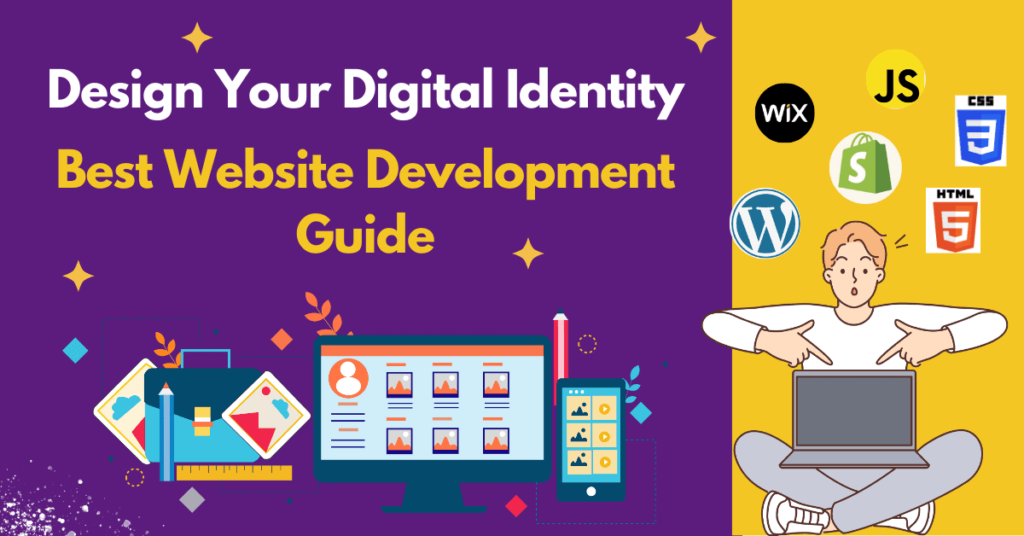Table of Contents
ToggleDesign Your Digital Identity: Best Website Development Guide
Understanding Your Brand: Defining Your Digital Identity
Certainly! Here’s a breakdown of key points to help you understand and define your brand’s digital identity:
- Know Your Values: Identify the core values and principles that your brand stands for. These values will form the foundation of your digital identity and guide your online presence.
- Define Your Audience: Understand your target audience demographics, including age, gender, interests, and preferences. Tailor your digital identity to resonate with this specific audience.
- Craft Your Unique Story: Every brand has a story. Share your brand’s journey, mission, and vision through compelling storytelling. Connect emotionally with your audience to create a lasting impression.
- Visual Identity: Develop a cohesive visual identity that reflects your brand’s personality. This includes elements such as logo, color palette, typography, and imagery. Consistency across all platforms is key to building brand recognition
- Voice and Tone: Establish a consistent voice and tone for your brand’s communication. Whether it’s friendly and informal or professional and authoritative, ensure it aligns with your brand values and resonates with your audience.
- Online Platforms Selection: Choose the right digital platforms to showcase your brand. Whether it’s a website, social media channels, or email marketing, select platforms that align with your audience’s preferences and behavior.
- Engagement Strategy: Develop an engagement strategy to interact with your audience effectively. Respond to comments, messages, and feedback promptly. Build relationships and foster community around your brand.
- Analytics and Feedback: Use analytics tools to track the performance of your digital identity. Monitor metrics such as website traffic, social media engagement, and conversion rates. Gather feedback from your audience to continuously refine and improve your brand’s digital presence.
By focusing on these points, you can gain a deeper understanding of your brand and effectively define its digital identity to connect with your target audience in meaningful ways.
Navigating the Design Process: Crafting a User-Centric Experience
Certainly! Here’s a concise guide on navigating the design process while crafting a user-centric experience:
Introduction:
- In the dynamic world of digital products, User Interface (UI) design plays a pivotal role in shaping user experiences.
- As technology evolves, the demand for intuitive and visually appealing interfaces has never been higher.
Understanding UI Design:
- UI design is the art and science of creating visually appealing and user-friendly interfaces for digital products (websites, mobile apps, software)
- It encompasses elements like layout, typography, color schemes, and interactive components to enhance user interaction.
Importance of UI Design:
- Effective UI design attracts users and ensures a seamless, enjoyable experience.
- It contributes to user satisfaction, engagement, and overall product success.
Key Principles of UI Design:
- Visual Hierarchy: Organize content logically, emphasizing important elements for easy navigation
- Consistency: Use consistent design elements (buttons, icons, colors) for familiarity and predictability.
- Feedback and Responsiveness: Provide visual cues and instant feedback to enhance user engagement.
- Simplicity and Clarity: Eliminate unnecessary elements, reducing cognitive load for users.
User-Centric Design:
- Prioritize end-users’ needs and preferences.
- Conduct user research and incorporate feedback throughout the design process.
Components of UI Design:
- Visual Design: Aesthetic aspects (color, typography, imagery, layout) communicate brand identity and enhance the user experience.
- Remember, crafting a user-centric experience involves empathy, consistency, and a keen understanding of your audience.

Choosing the Right Platform: Exploring Website Development Options
Content Management Systems (CMS):
WordPress: Renowned for its flexibility and user-friendliness, WordPress powers a significant portion of the internet. It offers numerous themes, plugins, and customization options suitable for various business needs.
Drupal: Known for its robustness and scalability, Drupal is favored for complex and large-scale websites. It provides powerful tools for customization but might have a steeper learning curve compared to WordPress.
Joomla: Positioned as a middle ground between WordPress and Drupal, Joomla offers a balance of ease of use and flexibility, making it suitable for medium-sized businesses with specific requirements.
Website Builders:
Wix: Known for its drag-and-drop interface and beginner-friendly approach, Wix is suitable for small businesses or individuals looking to create a visually appealing website without technical expertise.
Squarespace: Emphasizing design aesthetics, Squarespace offers elegant templates and a user-friendly interface, making it ideal for creative professionals or businesses focused on visual appeal.
Weebly: With a user-friendly interface and e-commerce capabilities, Weebly is suitable for small businesses seeking a simple yet functional website with built-in marketing tools.
Factors to Consider When Choosing:
Ease of Use: Consider the platform’s usability, especially if you have limited technical knowledge. A user-friendly interface can make website management smoother.
Customization and Scalability: Assess the level of customization needed and the platform’s scalability to accommodate future growth and additional functionalities.
Costs and Budget: Evaluate the initial costs, including hosting fees, domain registration, and any additional expenses related to plugins or themes.
Security and Support: Assess the platform’s security measures and the availability of customer support or community forums for troubleshooting.
Performance and Speed: Consider the platform’s performance metrics, especially loading speed, which impacts user experience and SEO rankings.
Optimizing for Success: Strategies for Effective Website Design
Responsive Design:
- Prioritize responsive design to ensure seamless user experiences across various devices.
- Optimize for mobile screens, considering touch interactions and smaller viewports.
- Boost search engine rankings by providing a consistent experience.
Website Performance Optimization:
- Speed matters: Optimize loading times for better user satisfaction.
- Use advanced techniques like image optimization, browser caching, and efficient content delivery networks (CDNs).
- Understand the symbiotic relationship between website speed and SEO.
User-Centric Navigation:
- Create intuitive navigation paths.
- Map user journeys and emphasize clear calls-to-action.
- Enhance overall user experience by simplifying navigation.
Content Creation and SEO:
- Craft engaging content aligned with SEO best practices.
- Prioritize quality over quantity
- Optimize meta tags, headings, and keywords for search engines.
Beyond Launch: Maintaining and Evolving Your Digital Presence
Certainly! After launching your website, ongoing maintenance and evolution are crucial for sustained success. Here are key strategies:
- CMS Maintenance: Keep your content management system (CMS) up to date. Regularly apply security patches and feature enhancements.
- Content Refresh: Update content periodically to stay relevant and engage users.
SEO Optimization:
- Keyword Monitoring: Continuously monitor keywords and adapt your content to align with search trends.
- Technical SEO: Optimize meta tags, improve site speed, and enhance mobile responsiveness.
Performance Monitoring:
- Analytics: Use tools like Google Analytics to track user behavior, identify bottlenecks, and improve user experience.
- Load Testing: Ensure your website can handle traffic spikes without performance degradation.
Security Measures:
- Regular Backups: Backup your website data to prevent data loss due to unforeseen events.
- SSL Certificates: Secure your site with HTTPS to protect user data and gain search engine favor.
User Experience Enhancements:
- Usability Testing: Continuously test your website’s usability and make adjustments based on user feedback.
- Mobile Optimization: Optimize for mobile devices to cater to a growing mobile audience.
Remember, maintaining and evolving your digital presence is an ongoing process.
Beyond Launch: Maintaining and Evolving Your Digital Presence
Certainly! After launching your website, ongoing maintenance and evolution are crucial for sustained success. Here are key strategies:
- CMS Maintenance: Keep your content management system (CMS) up to date. Regularly apply security patches and feature enhancements.
- Content Refresh: Update content periodically to stay relevant and engage users.
SEO Optimization:
- Keyword Monitoring: Continuously monitor keywords and adapt your content to align with search trends.
- Technical SEO: Optimize meta tags, improve site speed, and enhance mobile responsiveness.
Performance Monitoring:
- Analytics: Use tools like Google Analytics to track user behavior, identify bottlenecks, and improve user experience.
- Load Testing: Ensure your website can handle traffic spikes without performance degradation.
Security Measures:
- Regular Backups: Backup your website data to prevent data loss due to unforeseen events.
- SSL Certificates: Secure your site with HTTPS to protect user data and gain search engine favor.
User Experience Enhancements:
- Usability Testing: Continuously test your website’s usability and make adjustments based on user feedback.
- Mobile Optimization: Optimize for mobile devices to cater to a growing mobile audience.
Remember, maintaining and evolving your digital presence is an ongoing process.
Conclusion
Crafting your digital identity through effective Web Design & Development is a pivotal step in establishing a strong online presence. By following the guidance provided in the Best Website Development Guide, you can create a website that not only showcases your brand’s unique identity but also captivates and engages your audience. From defining your brand’s values and audience to selecting the right platforms and optimizing for search engines, every aspect covered in the guide contributes to building a compelling online presence.
FAQ
Web design refers to the process of creating the visual layout and aesthetic appearance of a website. It involves elements such as layout, color scheme, typography, and imagery to enhance user experience.
- Web development involves the technical aspects of building a website, including coding, programming, and implementing functionality. It brings the design to life by making the website interactive and functional.
- Web design focuses on the visual aspects and user interface of a website, while web development deals with the technical implementation and functionality. Designers create the look and feel, while developers handle the coding and programming.
- Skills required for web design include proficiency in graphic design software, understanding of user experience (UX) principles, knowledge of HTML and CSS, and creativity in visual aesthetics.
- Web development requires proficiency in programming languages such as HTML, CSS, JavaScript, and knowledge of frameworks like React or Angular. Understanding of server-side languages like PHP or Python is also beneficial.D
- Responsive web design is an approach to design and development that ensures a website adapts and responds to various screen sizes and devices, providing an optimal viewing experience for users across desktops, tablets, and smartphones.


